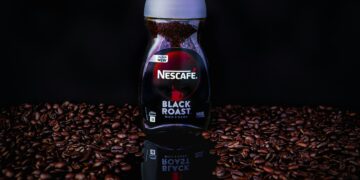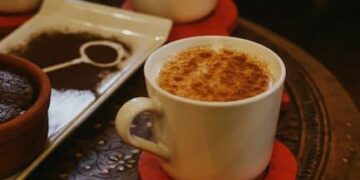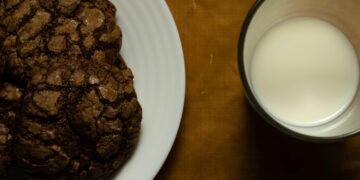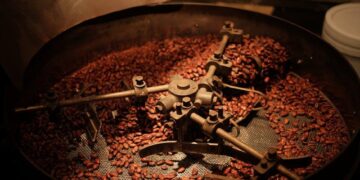Table of Contents
Every year, it’s the same ritual.
The first crisp breeze of late August arrives, and an internal clock, tuned to the rhythms of seasonal marketing, begins to tick.
It’s a craving, specific and potent, for the quintessential taste of autumn in a cup: the Dunkin’ Frozen Pumpkin Coffee.
I’d join the pilgrimage to the drive-thru, hand over my money, and for a few glorious minutes, all would be right with the world.
That first sip was a decadent rush of sweet, spicy, creamy, coffee-flavored slush.
But the magic was always fleeting, and the desire to replicate that experience at home became an annual obsession.
My journey, however, was a chronicle of failures.
I followed every online recipe, every blogger’s “perfect copycat.” I blended, I whisked, I prayed to the gourd gods.
Yet, the result was always the same heartbreaking disappointment.
What I created was not a beverage; it was a science experiment gone wrong.
A watery, separated mess would form within minutes.
The top layer was a weak, coffee-flavored liquid, while the bottom held a gritty sludge of pumpkin puree and spices.
Worst of all was the texture—a collection of crunchy, coarse ice crystals that bore no resemblance to the smooth, consistent texture of the original.
This wasn’t just a bad drink; it was a culinary mystery that I felt compelled to solve.
Why was this seemingly simple concoction so difficult to master? My frustration drove me past the recipe blogs and into a world I hadn’t expected: the fundamental physics and chemistry of food.
I discovered that the secret wasn’t in a specific ingredient, but in a completely different way of thinking about the drink itself.
This is the story of how I stopped trying to copy a recipe and started to understand the science, ultimately cracking the code to a frozen pumpkin coffee that puts the original to shame.
Part I: Deconstructing the Enigma – What’s Really in a Dunkin’ Frozen Pumpkin Coffee?
My investigation began where any good detective story does: with the subject itself.
To understand why my homemade versions were failing, I first needed to understand what I was up against.
I had to deconstruct the commercial Dunkin’ product, not just as a customer, but as a reverse engineer.
The basic construction, as observed and shared by Dunkin’ employees, seems simple enough.
A pitcher is filled with pumps of coffee syrup, pumps of a “pumpkin spice” swirl, and cream, which are then blended with i.e.1
But the devil, as they say, is in the details—specifically, in that “Pumpkin Flavored Swirl Syrup.” A look at Dunkin’s own ingredient guide reveals a startling truth.
The syrup’s primary components are sweetened condensed skim milk, sugar, high fructose corn syrup, water, and a blend of natural and artificial flavors.2
The most shocking revelation for many, myself included, is what’s missing: pumpkin.
The flavor is an artificial construct, a chemical mimicry of the real thing.4
This drink isn’t so much a pumpkin coffee as it is a coffee-flavored, pumpkin-
esque liquid candy.
The Nutritional Reality Check
This chemical composition leads directly to the second, more alarming discovery: the nutritional profile.
The numbers are, to put it mildly, staggering.
A single medium-sized Pumpkin Swirl Frozen Coffee with cream can pack between 890 and 930 calories and a jaw-dropping 181 to 185 grams of sugar.4
These are abstract figures, so let’s put them in perspective.
That one drink contains the sugar equivalent of 46 teaspoons of white sugar, or, more viscerally, 14 Dunkin’ glazed donuts.4
This information, which has caused a firestorm on social media platforms like TikTok, was a critical clue in my investigation.
This wasn’t just about sweetness; this extreme sugar load serves a crucial structural purpose.
In frozen applications, sugar acts as a powerful freezing point depressant.
It interferes with the ability of water molecules to form large ice crystals, resulting in a smoother, softer, less icy texture.7
Dunkin’ achieves its signature texture through a brute-force method: an overwhelming deluge of sugar.
It’s a cheap and effective industrial solution, but a nutritional catastrophe.
The Consumer Experience: A Tale of Two Drinks
This reliance on a high-sugar syrup also helps explain the wildly polarized public perception of the drink.
Online reviews are a battlefield of opinions, ranging from ecstatic “10/10” ratings and declarations of it being “amazing” 9 to scathing critiques calling it “terrible,” “cough syrup,” or even tasting bizarrely like “fireball” cinnamon whiskey.10
A recurring theme is the drink’s profound inconsistency.
Customers frequently complain that the taste is “a little bit off” compared to previous years or that the quality is entirely dependent on which employee prepares it.10
This points directly to the manual “pump” system used for the syrups.1
Because the syrup serves as both the primary flavor
and the primary texture agent, any variation in the number of pumps dramatically alters the final product.
Too few pumps, and it’s a weak, icy coffee.
Too many, and it becomes an intolerably sweet, cloying concoction.
The drink’s core design is inherently flawed, relying on a manual process that guarantees inconsistency.
This paradox lies at the heart of the product: the very element that creates its desirable texture (the massive sugar load) is also what makes it nutritionally questionable and wildly inconsistent.
To fully grasp the scale of this nutritional profile, a direct comparison is necessary.
Table 1: The Nutritional Showdown
| Item | Calories (approx.) | Sugar (approx.) |
| Dunkin’ Frozen Pumpkin Coffee (Medium, with cream) | 900 | 185 g |
| Dunkin’ Glazed Donut (1) | 260 | 12 g |
| Coca-Cola (12 oz can) | 140 | 39 g |
| Ben & Jerry’s Ice Cream (1 pint) | 1200 | 100 g |
Sources: 4
This table starkly illustrates that the Frozen Pumpkin Coffee is not a simple beverage; it’s a full-fledged dessert, containing significantly more sugar than an entire pint of premium ice cream.
This understanding solidified my mission: to create a version that could deliver the textural satisfaction without the nutritional assault and maddening inconsistency.
Part II: The Science of Failure – Why My Homemade Versions Kept Separating
Armed with a clear understanding of the commercial product, I could now diagnose my own failures with clinical precision.
My lumpy, separated, gritty disasters weren’t just bad luck; they were predictable outcomes of ignoring fundamental physics.
Each flaw I observed was a symptom of a deeper, systemic problem.
The Physics of a Bad Blend
A homemade frozen coffee is, at its core, a suspension—a mixture of solid particles (ice, pumpkin solids, spices) floating in a liquid (coffee, milk).
In an unstable suspension, physics is a relentless enemy.
- Ingredient Separation: The components of the drink have different densities. Heavier particles, like ice crystals and bits of pumpkin puree, are pulled downward by gravity, while lighter liquids, like the watery part of the coffee and milk, rise to the top.12 This is exactly what I was seeing in my glass: a stratified mess. Without a powerful binding agent to hold everything together, separation is not a possibility; it is an inevitability.
- The Ice Crystal Problem: The perceived texture of any frozen treat is dictated by the size of its ice crystals. The goal is to keep them microscopic and uniform. Commercial machines achieve this by freezing the mixture very quickly while constantly churning it.8 At home, the slow freezing process in a standard freezer gives water molecules ample time to find each other and form large, crunchy, unpleasant crystals.7 My homemade attempts were high in “free water”—unbound water molecules ready to form these massive crystals—which is why they tasted more like coffee-flavored hail than a smooth, creamy beverage.
- The Gritty Truth About Spices: This was perhaps my most naive mistake. I, like many home cooks, was simply dumping ground spices like cinnamon, nutmeg, and cloves into the blender. But these spices are not water-soluble; they are essentially finely ground tree bark and seeds. They will never dissolve.15 Instead, they remain as suspended solids, creating a “sandy” or “gritty” mouthfeel that ruins the creamy illusion.16
These individual failures are not isolated incidents.
They are part of an interconnected cascade.
A watery base, lacking proper structure, not only allows large ice crystals to form but also provides a low-viscosity environment where denser particles can easily and quickly fall out of suspension, accelerating separation.
The gritty spices further disrupt any chance of achieving a smooth texture.
It became clear that fixing one problem in isolation was a fool’s errand.
I couldn’t just blend longer or use finer spices.
I had to address the fundamental, unstable structure of the liquid itself.
Part III: The Epiphany – It’s Not a Drink, It’s an Emulsion
After weeks of failed attempts and growing frustration, I realized I was asking the wrong question.
I had been trying to find the right recipe, when I should have been trying to understand the right principle.
The breakthrough came when I stopped thinking of the drink as a simple mixture and started seeing it for what it truly is: a complex physical structure.
A perfect frozen coffee is a carefully constructed emulsion—a stable, homogenous mixture of fat, water, and air.17
This realization was my turning point.
To make the abstract concept of food science tangible, I developed an analogy that became my guiding principle.
My Analogy: Paving a Road
Making a frozen coffee is like paving a road.
You start with disparate materials: coarse gravel (the ice), fine sand (the pumpkin and flavor solids), and a liquid binder (the coffee and milk).
If you just toss them together and stir, you get a lumpy, unstable mess.
The moment you stop stirring, the gravel and sand settle O.T. To create a smooth, durable road surface, you need asphalt—a powerful binding agent (an emulsifier) that coats every single particle, big and small, suspending them in a stable matrix.
This binder is what transforms a loose pile of ingredients into a unified, functional structure.
With this new framework, I had a new mission: find the “asphalt” for my frozen coffee.
This led me to two crucial, and often misunderstood, ingredients in the modernist pantry: emulsifiers and stabilizers.
Introducing the Toolkit: Emulsifiers and Stabilizers
- Lecithin (The Emulsifier): Lecithin is the “asphalt binder” in my road-paving analogy. It’s a natural substance found in sources like sunflower seeds and soy. Its power lies in its molecular structure: each molecule has a “head” that is attracted to water (hydrophilic) and a “tail” that is attracted to fat (lipophilic).19 When added to a mixture of fat (from milk or cream) and water (from coffee), lecithin molecules arrange themselves at the interface, physically bridging the gap between the two immiscible liquids. This creates a creamy, unified texture and powerfully prevents the kind of separation I had been fighting.20 For a water-dominant application like a frozen coffee, powdered lecithin is the ideal form, as it dissolves more readily than its liquid counterpart.22
- Xanthan Gum (The Stabilizer): If lecithin is the binder, xanthan gum is the “structural fiber” mixed into the pavement. It is a hydrocolloid, a substance that forms a gel in contact with water. Its role is twofold and absolutely critical. First, it dramatically increases the viscosity of the liquid base. This thickened matrix physically traps water molecules, preventing them from migrating and forming the large, crunchy ice crystals that plagued my earlier attempts.7 Second, this same viscosity creates a thick medium that holds all the solid particles—the ice, the pumpkin puree, the spices—in perfect suspension, defying gravity and stopping separation in its tracks.25
It became clear that the true professional secret wasn’t using one or the other, but understanding their synergy.
Lecithin solves the oil-water separation problem at a molecular level, creating the foundational creaminess.
Xanthan gum then protects and reinforces that emulsion, solving the physical problems of ice crystal growth and particle suspension by increasing viscosity.
They are not redundant tools; they are a complementary one-two punch that solves two different, but related, physical challenges.
This was the expert-level key that almost every online recipe was missing.
To demystify these powerful ingredients, I created a simple reference guide.
Table 2: The Home Barista’s Texture Toolkit
| Agent | Primary Function | Typical Usage Rate (% of total liquid weight) | Pro-Tips for Incorporation |
| Lecithin (Powdered) | Emulsifier (Binds Fat & Water) | 0.5%−1.0% | Dissolve in a small amount of warm liquid first, or mix thoroughly with other dry ingredients (like sugar) before blending. 20 |
| Xanthan Gum | Stabilizer/Thickener (Controls Ice & Suspension) | 0.1%−0.25% | To prevent clumping, disperse in a small amount of oil or sugar to make a slurry before adding to the blender under high shear. 24 |
| Guar Gum | Stabilizer/Thickener (Alternative to Xanthan) | 0.1%−0.3% | Similar to xanthan gum; provides excellent viscosity but can have a slightly different mouthfeel. Some users prefer it for creaminess. 24 |
This toolkit was the final piece of the puzzle.
I was no longer a frustrated consumer randomly mixing ingredients.
I was an architect, ready to build a better beverage from the ground up.
Part IV: The Solution – A Master Framework for Perfect Frozen Coffee
With theory and tools in hand, I finally developed a perfected, replicable workflow.
This isn’t just a recipe; it’s a four-step framework grounded in science, designed to give you complete control over the final product.
Step 1: Building the Flavor Base – The Perfect Pumpkin Spice Syrup
The first order of business is to solve the “gritty spice” problem.
We achieve this by creating a smooth, concentrated flavor syrup that can be seamlessly integrated into the final blend.
The key is to infuse the flavor of the spices into the syrup and then strain out the solid particles.
The process is straightforward but requires care.
You must start with 100% pure pumpkin puree, not canned pumpkin pie filling, which is already sweetened and spiced, robbing you of control.34
You’ll gently simmer water, a sweetener like brown sugar or maple syrup, the pumpkin puree, and your spices.
For the absolute smoothest result, use whole spices like cinnamon sticks and whole cloves, which are easily removed.
If using ground spices, the final straining step is non-negotiable.
The mixture must be passed through a fine-mesh sieve, cheesecloth, or even a coffee filter to remove every last bit of grit.36
The result is a silky, intensely flavored syrup that forms the heart of your drink.
Step 2: Choosing Your Foundation – Coffee and Milk
- The Coffee: The flavor of your coffee needs to be robust enough to stand up to the milk, pumpkin, and spices. Weak, watery coffee will result in a bland, diluted drink. The best options are strongly brewed hot coffee, a double shot of espresso, or a high-quality cold brew concentrate.39 The goal is concentrated coffee flavor, not just brown-colored water.34
- The Milk: The fat in your milk is a crucial component of the emulsion. Whole dairy milk provides ample fat for the lecithin to bind with, creating a rich mouthfeel. For dairy-free versions, oat milk is widely praised as the best option due to its creamy consistency and superior frothing ability.42 Soy milk is another excellent choice that froths well and contributes to a stable emulsion.44
Step 3: The Emulsification Process – The Magic of Incorporation
This is the most important technical step, where we add our texture agents.
How you add them is as important as what you add.
- Lecithin: To ensure the powdered lecithin disperses evenly without clumping, it’s best to mix it with your other dry ingredients, such as sugar, before they hit the liquid.28
- Xanthan Gum: Xanthan gum is notorious for clumping into a slimy mess if added incorrectly. The professional technique is to use high shear (a running blender) to incorporate it. Create a vortex with your liquid ingredients in the blender, then slowly sprinkle the xanthan gum into the moving liquid.31 An even more foolproof method is to create a “slurry”: in a small bowl, mix the tiny amount of xanthan gum (e.g., 1/4 teaspoon) with a tablespoon of a neutral oil or sugar. This coats each particle, preventing them from clumping together when they hit the main liquid.32
Step 4: The Final Blend – Order of Operations
The sequence in which you add ingredients to the blender directly impacts the stability of the final emulsion.12
Follow this order for perfect results:
- Liquids First: Pour in your milk, coffee, and the prepared pumpkin spice syrup. This allows the blender blades to spin freely and create a powerful vortex.
- Powders and Texture Agents: Add your lecithin (mixed with sugar) and the xanthan gum slurry. Blend for a few seconds to fully incorporate these agents into the liquid base.
- Solids Last: Add your ice. If you want an even creamier texture, you can substitute some of the ice with a frozen banana, which also acts as a natural thickener.
- Blend: Blend on high speed for at least 30 to 60 seconds. This high-shear action is critical for fully hydrating the xanthan gum and creating the smallest possible ice crystals, resulting in the smoothest possible texture.12
Following this framework, here is the master recipe that resulted from my journey.
Table 3: The Ultimate Homemade Frozen Pumpkin Coffee Recipe
| Component | Ingredients | Instructions |
| Part 1: Smooth Pumpkin Spice Syrup | – 1 cup Water – ¾ cup Brown Sugar – ½ cup 100% Pumpkin Puree – 2 Cinnamon Sticks – 4 Whole Cloves – ½ tsp Ground Ginger – ¼ tsp Ground Nutmeg – 1 tsp Vanilla Extract | 1. In a small saucepan, combine water, brown sugar, pumpkin puree, and all spices except vanilla. 2. Bring to a simmer over medium heat, stirring until sugar dissolves. 3. Reduce heat to low and let simmer gently for 10 minutes to infuse flavors. 4. Remove from heat and strain through a fine-mesh sieve lined with cheesecloth to remove all solids. Press gently on the solids to extract all liquid. 5. Stir in the vanilla extract. Let cool completely. Store in an airtight container in the refrigerator for up to 2 weeks. |
| Part 2: Frozen Coffee Assembly (16 oz serving) | – 1 cup Whole Milk (or Oat Milk for dairy-free) – ½ cup Strong Brewed Coffee or 2 shots Espresso, chilled – 3 tbsp Smooth Pumpkin Spice Syrup (from Part 1) – 1 ½ cups Ice – ½ tsp Powdered Sunflower Lecithin – ¼ tsp Xanthan Gum | 1. Prepare Texture Agents: In a small bowl, mix the xanthan gum with 1 tsp of neutral oil or sugar to create a clump-free slurry. In another small bowl, whisk the lecithin powder with 1 tbsp of your milk until dissolved. 2. Blend Liquids: In a high-powered blender, combine the remaining milk, chilled coffee, and pumpkin spice syrup. 3. Incorporate Agents: Add the dissolved lecithin and the xanthan gum slurry to the blender. Blend on low for 10 seconds to combine. 4. Add Ice & Blend: Add the ice to the blender. Start on low and quickly ramp up to high speed. Blend for 45-60 seconds, or until completely smooth and thick. 5. Serve Immediately: Pour into a chilled glass and top with whipped cream and a sprinkle of cinnamon, if desired. |
Part V: Troubleshooting and Customization Guide
This framework is robust, but the kitchen is a place of variables.
This guide will help you fine-tune the recipe to your exact preferences and troubleshoot any issues that arise.
Troubleshooting Chart
| Problem | Likely Cause | Solution |
| “My drink is too thick/goopy.” | Too much xanthan gum was used. | The “snotty” texture is a classic sign of overuse.33 Reduce the amount by half in your next attempt (e.g., to 1/8 tsp). |
| “My drink is too thin.” | Not enough xanthan gum or too much liquid. | Add another 1/8 tsp of xanthan gum (prepared as a slurry) and re-blend for 30 seconds. |
| “My drink separated after blending.” | Insufficient emulsifier/stabilizer or inadequate blending. | This indicates the emulsion didn’t form correctly. Ensure you used both lecithin and xanthan gum and blended on high speed. You can often save it by re-blending on high.13 |
| “My drink is still a bit icy.” | Not enough stabilizer for the amount of water, or slow freezing. | Ensure your xanthan gum ratio is correct. For a virtually ice-free texture, replace half of the water-based ice cubes with frozen coffee cubes or a piece of frozen banana.8 |
The Health-Conscious Spin
The beauty of this framework is that you are in complete control of the sugar content.
- Sweeteners: You can replace the brown sugar in the syrup with natural, non-nutritive sweeteners. Allulose is an excellent choice, as are blends of monk fruit and erythritol.47
- A Note on Texture: When you remove sugar, you also remove its viscosity-enhancing and freezing-point-depressing properties. This makes the role of xanthan gum even more critical. You may find you need to slightly increase the amount of xanthan gum (e.g., from 1/4 tsp to a scant 1/2 tsp) to achieve the same smooth, non-icy texture in a sugar-free version.
The Dairy-Free/Vegan Masterpiece
This framework is naturally suited for vegan and dairy-free preparations.
- Milk: As noted, full-fat oat milk is the top contender for creaminess, with soy milk being a close second.42
- Toppings: A high-quality coconut whipped cream makes an excellent substitute for dairy-based whipped cream.50
- Lecithin: Ensure you are using sunflower lecithin, as soy lecithin can be a concern for those with soy allergies.
Beyond Pumpkin
Once you master the technique, you can apply it to any flavor profile.
The core framework remains the same: Flavor Base + Liquid Foundation + Texture Toolkit. Replace the pumpkin spice syrup with a high-quality chocolate syrup for a Frozen Mocha, or a caramel sauce for a Frozen Caramel Coffee.
The principles of emulsification and stabilization are universal.
Conclusion: From Frustrated Consumer to Empowered Creator
My journey began with a simple craving and a series of frustrating failures.
It led me down a path from blindly following recipes to fundamentally understanding the science at play in my blender.
The final product—a smooth, creamy, perfectly spiced frozen coffee with a fraction of the sugar and none of the inconsistency of the commercial version—is immensely satisfying.
But the true reward wasn’t just cracking the code to a single drink.
The real transformation was in the mindset.
By learning why things work in the kitchen, we move beyond being mere instruction-followers and become true creators.
Understanding the principles of an emulsion, the behavior of ice crystals, and the role of hydrocolloids gives you the power to not only replicate a recipe but to improve it, adapt it, and invent your own.
The goal was to make a great frozen coffee, but the prize was gaining a small piece of culinary mastery.
And that is a flavor far more satisfying than any seasonal special could ever be.
Works cited
- Pumpkin Spice Frozen Coffee coming to your local @Dunkin’ 8/16/23 #cap… | TikTok, accessed August 3, 2025, https://www.tiktok.com/@fazatdunkin/video/7266866713705172267
- Allergen and Ingredient Guide | Dunkin’ Donuts, accessed August 3, 2025, https://www.dunkindonuts.com/content/dam/dd/pdf/allergy_ingredient_guide.pdf
- Iced Pumpkin Spice Latte (Dunkin)! – The Hint of Rosemary, accessed August 3, 2025, https://thehintofrosemary.com/iced-pumpkin-spice-latte/
- A large pumpkin swirl frozen coffee drink contains 185 grams of sugar – TikTok, accessed August 3, 2025, https://www.tiktok.com/@dailyoriginalvids/video/7413069385365065002
- Unhealthy Truth About Dunkin’ Donuts Pumpkin Swirl Frozen Coffee | TikTok, accessed August 3, 2025, https://www.tiktok.com/@bobbyparrish/video/7277681759775427882
- Going through the ingredients of the New Pumpkin Swirl Frozen Coffee at Dunkin Donuts. Someone needs to explain how this is actually legal to serve to people. It contains 46 teaspoons of sugar (185 grams). : r/ultraprocessedfood – Reddit, accessed August 3, 2025, https://www.reddit.com/r/ultraprocessedfood/comments/1f5ms5e/going_through_the_ingredients_of_the_new_pumpkin/
- Reducing ice crystals : r/icecreamery – Reddit, accessed August 3, 2025, https://www.reddit.com/r/icecreamery/comments/j62yg1/reducing_ice_crystals/
- 5 Common Homemade Ice Cream Issues (& How to Fix Them) – Food52, accessed August 3, 2025, https://food52.com/story/13333-5-common-homemade-ice-cream-issues-how-to-fix-them
- Dunkin’s Pumpkin Frozen Coffee: A Fall Favorite – Lemon8 app, accessed August 3, 2025, https://www.lemon8-app.com/@janellyy.__/7420155030675784198?region=us
- Pumpkin iced coffee : r/DunkinDonuts – Reddit, accessed August 3, 2025, https://www.reddit.com/r/DunkinDonuts/comments/1ff6250/pumpkin_iced_coffee/
- The pumpkin frozen coffee tastes like fireball : r/DunkinDonuts – Reddit, accessed August 3, 2025, https://www.reddit.com/r/DunkinDonuts/comments/163p5oa/the_pumpkin_frozen_coffee_tastes_like_fireball/
- Why Your Smoothie Separates: Doctor-Approved Solutions | Lifeboost Coffee, accessed August 3, 2025, https://lifeboostcoffee.com/blogs/lifeboost/why-your-smoothie-separates-doctor-approved-solutions
- Here’s Why Your Frozen Drink Separated – Tasting Table, accessed August 3, 2025, https://www.tastingtable.com/1355189/reason-frozen-drink-separated/
- How can I control ice crystal size in home made pure juice lollies – Seasoned Advice, accessed August 3, 2025, https://cooking.stackexchange.com/questions/90950/how-can-i-control-ice-crystal-size-in-home-made-pure-juice-lollies
- [Noob Question] How to get spices to mix into Pumpkin Spice Latte? : r/Coffee – Reddit, accessed August 3, 2025, https://www.reddit.com/r/Coffee/comments/iu9pp2/noob_question_how_to_get_spices_to_mix_into/
- Smooth and Pumpkiny Pumpkin Spice Latte Recipe – cuppacocoa, accessed August 3, 2025, https://cuppacocoa.com/smooth-and-pumpkiny-pumpkin-spice-latte-recipe/
- Emulsion – Food Literacy Center, accessed August 3, 2025, https://www.foodliteracycenter.org/food-wiki/emulsion
- What are emulsifiers and what are common examples used in food? | Eufic, accessed August 3, 2025, https://www.eufic.org/en/whats-in-food/article/what-are-emulsifiers-and-what-are-common-examples-used-in-food
- Baker’s Guide to Lecithin, How To Use this Baking Ingredient | Ultimate Baker, accessed August 3, 2025, https://ultimatebaker.com/baker-s-guide-to-lecithin/
- Lecithin in Cooking: Functions, Benefits & How to Use – Cape Crystal Brands, accessed August 3, 2025, https://www.capecrystalbrands.com/blogs/cape-crystal-brands/a-guide-to-lecithin-in-cooking
- Soy Lecithin in Cake Baking: A Versatile Ingredient for Texture and Stability, accessed August 3, 2025, https://www.tannov.com/marbella-cake-boutique-blog/soy-lecithin-in-cake-baking-a-versatile-ingredient-for-texture-and-stability
- A Lesson in Lecithin – Kitchen Alchemy, accessed August 3, 2025, https://blog.modernistpantry.com/advice/a-lesson-in-lecithin/
- Lecithin | alchemyacademy.world, accessed August 3, 2025, https://alchemyacademy.world/lecithin/
- The Ultimate Guide to Emulsification in Frozen Treats – Number Analytics, accessed August 3, 2025, https://www.numberanalytics.com/blog/ultimate-guide-to-emulsification-in-frozen-treats
- How to keep smoothies from separating? : r/cookingforbeginners – Reddit, accessed August 3, 2025, https://www.reddit.com/r/cookingforbeginners/comments/t1ppi7/how_to_keep_smoothies_from_separating/
- Should You Worry About Xanthan Gum? – CNET, accessed August 3, 2025, https://www.cnet.com/health/nutrition/what-is-xanthan-gum-and-is-it-safe-we-asked-experts/
- Xanthan Gum Is The Secret Ingredient For Better Frozen Cocktails – Food Republic, accessed August 3, 2025, https://www.foodrepublic.com/1350485/tips-better-frozen-cocktails-xanthan-gum/
- Using Sunflower Lecithin to improve your baking – Lekithos® Inc., accessed August 3, 2025, https://lekithos.com/blogs/recipes/using-sunflower-lecithin-to-improve-your-baked-goods
- Two Ingredients You Didn’t Know You Need : r/TopSecretRecipes – Reddit, accessed August 3, 2025, https://www.reddit.com/r/TopSecretRecipes/comments/dg0re8/two_ingredients_you_didnt_know_you_need/
- Easy Thickening with Xanthan Gum | The Protein Chef – TikTok, accessed August 3, 2025, https://www.tiktok.com/@theproteinchef/video/7095000725171997998
- www.amazingfoodmadeeasy.com, accessed August 3, 2025, https://www.amazingfoodmadeeasy.com/info/modernist-ingredients/more/xanthan-gum#:~:text=To%20add%20xanthan%20gum%20sprinkle,adding%20it%20to%20the%20liquid.
- How to work with xanthan gum powder : r/AskCulinary – Reddit, accessed August 3, 2025, https://www.reddit.com/r/AskCulinary/comments/d8axb8/how_to_work_with_xanthan_gum_powder/
- Any tips when using Xanthan Gum for drinks? : r/Cooking – Reddit, accessed August 3, 2025, https://www.reddit.com/r/Cooking/comments/6x34bo/any_tips_when_using_xanthan_gum_for_drinks/
- Pumpkin Spice Frozen Latte Recipe – The Kitchn, accessed August 3, 2025, https://www.thekitchn.com/pumpkin-spice-frozen-latte-recipe-23573391
- Pumpkin Spice Latte Recipe | Gimme Some Oven, accessed August 3, 2025, https://www.gimmesomeoven.com/pumpkin-spice-latte/
- Homemade Pumpkin Spice Syrup Recipe for Coffee, accessed August 3, 2025, https://mittengirl.com/homemade-pumpkin-spice-simple-syrup/
- Homemade Pumpkin Spice Coffee Syrup (with Real Pumpkin) – Sip + Sanity, accessed August 3, 2025, https://www.sipandsanity.com/pumpkin-spice-coffee-syrup/
- How can I filter the solids out of my homemade pumpkin spice syrup? – Seasoned Advice, accessed August 3, 2025, https://cooking.stackexchange.com/questions/122969/how-can-i-filter-the-solids-out-of-my-homemade-pumpkin-spice-syrup
- Dunkin Copycat Pumpkin Cream Cold Brew – Small Farm Big Life, accessed August 3, 2025, https://smallfarmbiglife.com/dunkin-copycat-pumpkin-cream-cold-brew/
- Homemade Pumpkin Spice Latte – Feel Good Foodie, accessed August 3, 2025, https://feelgoodfoodie.net/recipe/homemade-pumpkin-spice-latte/
- The Best Homemade Pumpkin Spice Latte & My Coffee Journey – beyondgumbo, accessed August 3, 2025, https://beyondgumbo.com/2023/10/15/__trashed-3/
- Dairy-Free Pumpkin Spice Latte | Vegan – Good Food Baddie, accessed August 3, 2025, https://goodfoodbaddie.com/dairy-free-pumpkin-spice-latte-vegan/
- Vegan Homemade Pumpkin Spice Latte That Tastes Like Fall, accessed August 3, 2025, https://sagealphagal.com/homemade-pumpkin-spice-latte/
- Vegan Pumpkin Spice Latte (Starbucks Copycat), accessed August 3, 2025, https://veganhuggs.com/vegan-pumpkin-spice-latte/
- The Most Common Smoothie Problems (& How to Solve Them) – Food52, accessed August 3, 2025, https://food52.com/story/15543-the-most-common-smoothie-problems-how-to-solve-them
- Frozen Coffee (Dunkin Donuts Copycat) – Sugar and Soul, accessed August 3, 2025, https://www.sugarandsoul.co/frozen-coffee-dunkin-copycat/
- 6 Healthy Ways to Sweeten Your Coffee, accessed August 3, 2025, https://esquirescoffee.co.uk/news/healthy-ways-sweeten-coffee/
- Are there any natural sweeteners that work well with coffee?, accessed August 3, 2025, https://coffee.stackexchange.com/questions/3205/are-there-any-natural-sweeteners-that-work-well-with-coffee
- How to Sweeten Coffee Without Sugar: 5 Easy Methods to Try – 2025 – MasterClass, accessed August 3, 2025, https://www.masterclass.com/articles/how-to-sweeten-coffee-without-sugar
- Vegan Pumpkin Spice Latte for Less Than $2 : r/EatCheapAndVegan – Reddit, accessed August 3, 2025, https://www.reddit.com/r/EatCheapAndVegan/comments/17z226d/vegan_pumpkin_spice_latte_for_less_than_2/
- Dairy-Free Pumpkin Spice Latte For Less Than $2 – YouTube, accessed August 3, 2025, https://www.youtube.com/watch?v=uzCAKubqBvU






